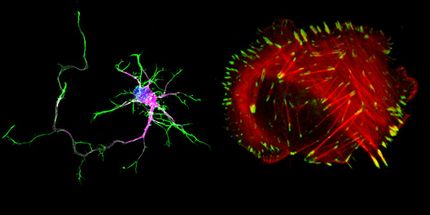New treatment for specific type of leukemia
Chronic Eosinophilic leukemia (CEL), a specific form of leukemia, is currently treated with Glivec. However, recent research has shown that prolonged usage can cause resistance to Glivec, rendering this chronic form of leukemia untreatable. Researchers from the Flanders Interuniversity Institute for biotechnology (VIB) connected to the Catholic University of Leuven have now discovered that another drug, Sorafenib (Nexavar), works on patients that have developed this resistance. This finding is not only important for CEL patients, but it also provides a new approach for treating specific forms of leukemia. It is clear from this research that a combination of targeted drugs provides a greater chance of lifelong effective treatment.
Chronic leukemia appears in several forms in CEL, a rare form of leukemia, the excessive increase of eosinophils (a certain type of white blood cell) can cause tissue damage in the heart, the skin, and the central nervous system. Under normal circumstances, our body regulates the production of white blood cells very precisely by means of a targeted activation of tyrosine kinases, which start this production. But sometimes defects in the DNA cause these tyrosine kinases to be active continuously, giving rise to diseases like leukemia. In 2003, Jan Cools and his colleagues under the direction of Peter Marynen, along with colleagues Elizabeth Stover and Gary Gilliland from Boston, discovered that CEL is caused by this kind of defective activation of the tyrosine kinase FIP1L1-PDGFR. Now, with additional research, they have uncovered the molecular mechanism behind the abnormal activation of FIP1L1-PDGFR.
In the fight against CEL (and other forms of leukemia), scientists use proteins that inhibit the tyrosine kinases. Glivec is such an inhibitor and is effective against CEL because it specifically inhibits the activity of FIP1L1-PDGFR. However, CEL patients must take Glivec every day for the rest of their lives and recent research shows that, over time, alterations in the DNA can arise, causing resistance to Glivec. The longer Glivec is taken, the greater the chance resistance will develop. At that point, treatment with Glivec is no longer effective.
This problem prompted VIB researchers Els Lierman and Jan Cools to look for alternatives. They have found that Sorafenib, another inhibitor, works effectively in treating the resistant form of CEL. Sorafenib is already on the market in the US as a remedy for kidney tumors. This new research indicates that, to be able to treat certain forms of leukemia (like CEL) effectively over a long period of time, several inhibitors must be used, either together or successively. The scientists emphasize the importance of testing known inhibitors for their effectiveness against CEL and other forms of leukemia. This research has recently appeared in the scientific journal Blood.
Original publications: Stover et al.; "Activation of FIPL1-PDGFR requires disruption of the juxtamembrane domain of PDGFR and is FIP1L1-independent"; PNAS 2006.
Lierman et al.; "Sorafenib (BAY43-9006) is a potent inhibitor of FIPL1-PDGFR and the imatinib resistant FIP1L1-PDGFR T674I mutant"; Blood 2006.
Other news from the department science

Get the life science industry in your inbox
By submitting this form you agree that LUMITOS AG will send you the newsletter(s) selected above by email. Your data will not be passed on to third parties. Your data will be stored and processed in accordance with our data protection regulations. LUMITOS may contact you by email for the purpose of advertising or market and opinion surveys. You can revoke your consent at any time without giving reasons to LUMITOS AG, Ernst-Augustin-Str. 2, 12489 Berlin, Germany or by e-mail at revoke@lumitos.com with effect for the future. In addition, each email contains a link to unsubscribe from the corresponding newsletter.





















































